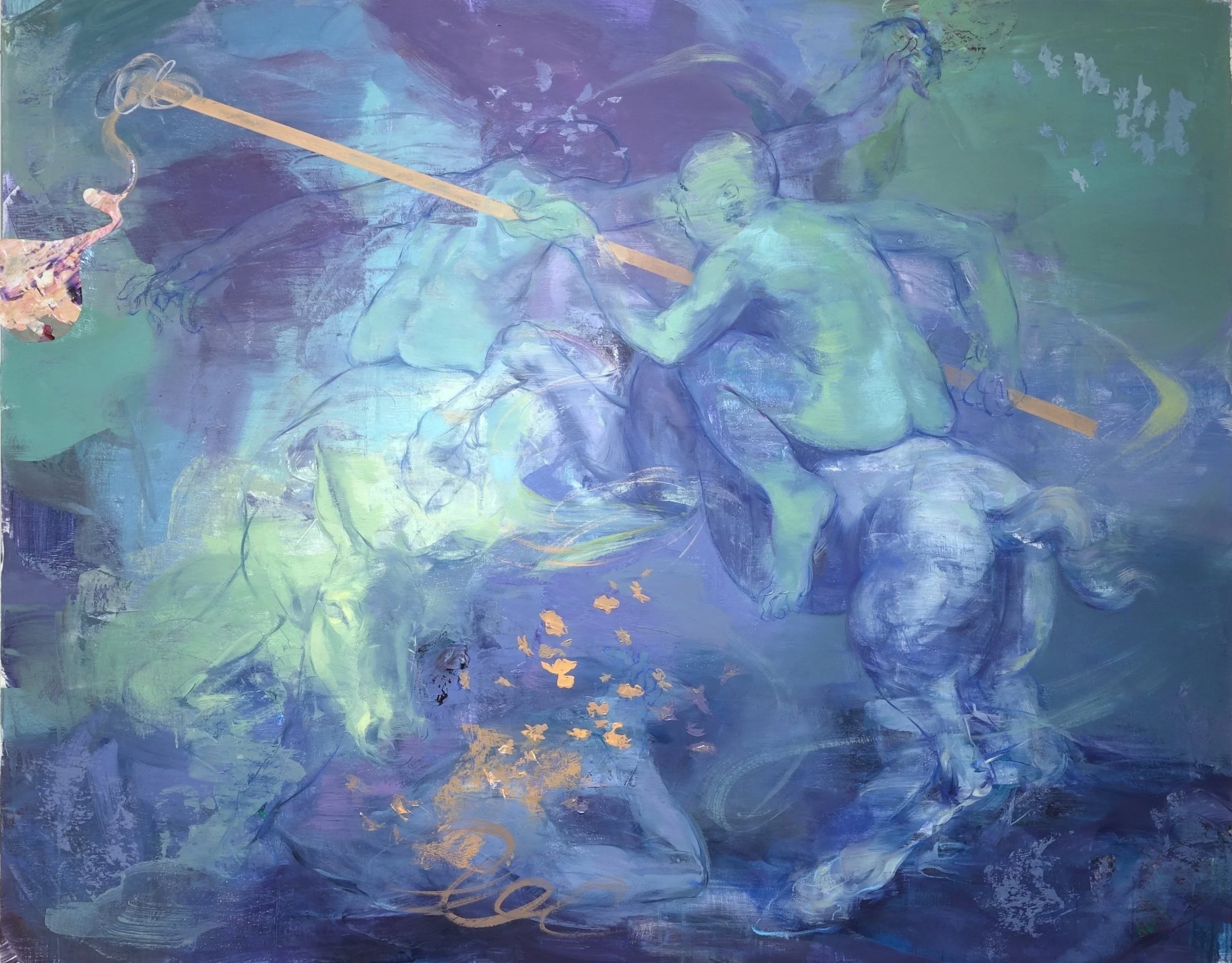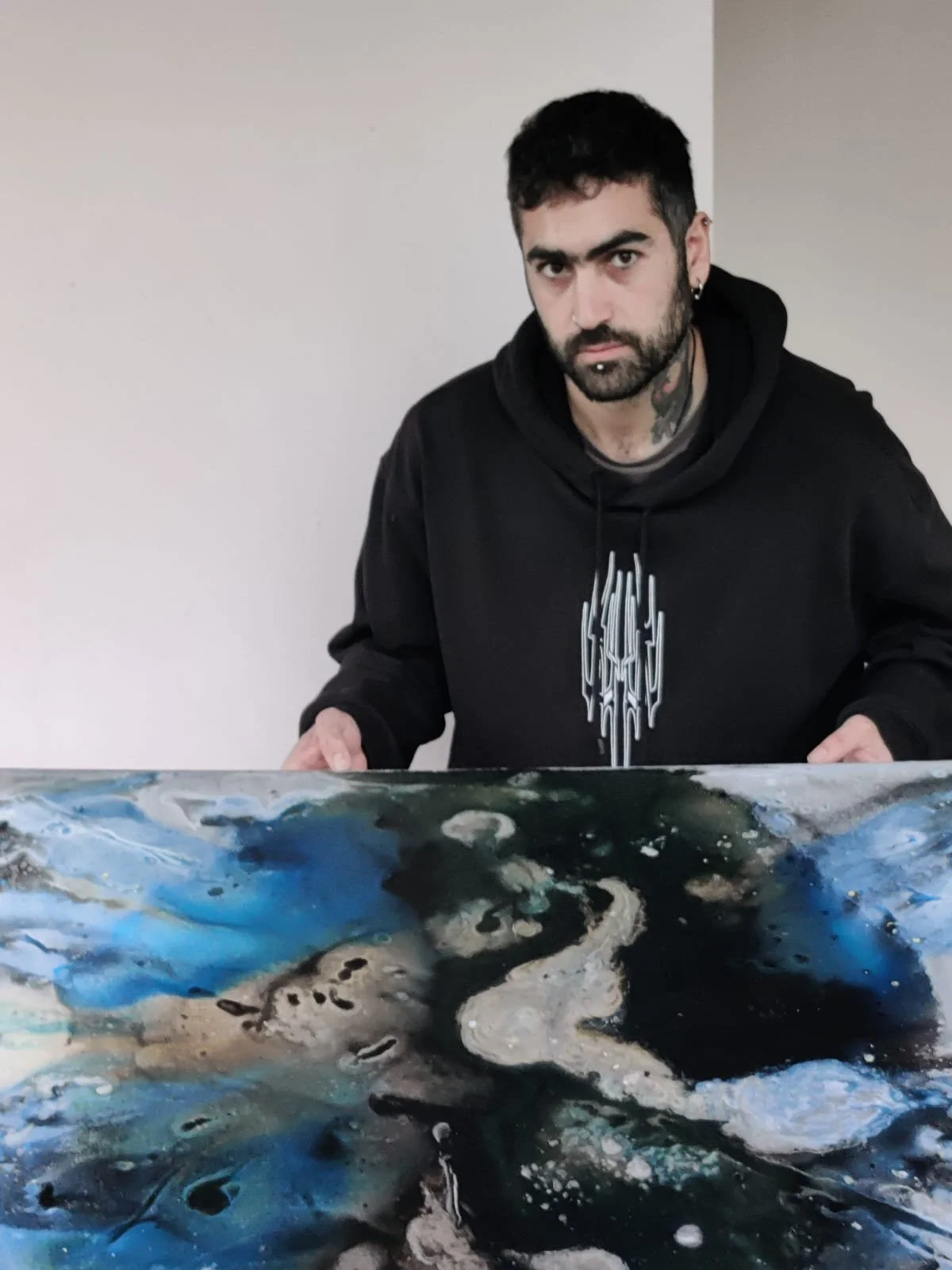10 Questions with Mingxuan Zhang
Al-Tiba9 Art Magazine ISSUE18 | Featured Artist
Zhang Mingxuan (b. 1998, China) graduated in 2020 with a bachelor’s degree from Central Saint Martins College of Arts and Design in the UK and completed her master’s degree at the Royal College of Art in 2023. She currently resides and works in both London and Hong Kong.
Zhang’s artistic practice centres on the fluidity and de-symbolisation of the body, exploring the complex relationship between the body, space, and gaze through distortion and absence. She creatively incorporates ready-made fabrics from the real world into her paintings, capturing the transition between the “virtual” and the “real.” By using tangible materials to cover and envelop the “virtual body” in her artwork, Zhang reflects on the physical condition within the real world. In many of her pieces, the canvas transforms into a frame or container, subjecting the depicted subjects to external pressures. Through this technique, she challenges and reexamines societal definitions of the body, as well as the meanings and connotations that bodily images can carry.
Zhang is also intrigued by the differing perspectives on body and space between the East and the West. Her works express contradictions and oppositions, encapsulation and fusion, offering a unique interpretation of life experiences shaped by her multicultural background.
Mingxuan Zhang - Portrait
ARTIST STATEMENT
Zhang Mingxuan’s practice revolves around the fluidity and de-symbolisation of the body, exploring the relationship between the body, space, and intimacy through distortion and absence. She views the canvas as both a frame and a container, applying external forces and pressure to the subjects within. This allows her to repeatedly examine societal interpretations of the body and the implications of bodily imagery. Zhang is particularly intrigued by the differences between Eastern and Western perspectives on the body and its philosophy. Her experiences living within multiple cultures provide her work with a dual perspective.
Her paintings are often inspired by her performance art. Before starting each new series of paintings, she experiences a compelling desire to act, which exists in both her consciousness and body. This desire becomes a catalyst for her creative process. One series of works features the body trapped in black threads, struggling to escape their tightness. These works are inspired by a performance in which she wore a bodysuit made of silk stockings as a second skin and crawled through woods and stones. Over time, the second skin became torn and tattered. Zhang brought the damaged skin back to her studio, using it as a starting point to create paintings that symbolise both vulnerability and the violence of breaking free.
In her paintings, bodies emerge from a shared dark background, with heads often minimised or entirely erased. Her intention is to strip away everything extraneous to the body, such as identity, race, and hierarchy, to directly confront the essence of the body itself. As Nietzsche said, “Body am I entirely, and nothing more.”
Unüeiled, Mixed media on silk, 320 x 200 cm, 2023 © Mingxuan Zhang
AL-TIBA9 ART MAGAZINE ISSUE18
INTERVIEW
Let's start from the basics. Can you share with our readers the journey that led you to pursue an art career? When did you first realise you wanted to be an artist?
I think it was the first time I saw Louise Bourgeois' red ink drawings at Tate Modern, which left a profound impression and inspiration on me. It made me start thinking about why I was so deeply moved by an artwork, which gradually led me to learn and eventually become an artist.
How did studying at Central Saint Martins and the Royal College of Art help you develop into the artist you are today?
My time at Central Saint Martins felt like opening the door to a whole new world. At first, I experienced a strong cultural shock, trying to figure out what art truly was in a place where it seemed like everyone was an artist. But it was also a period when I gradually came to understand myself and what I wanted to do. I developed an interest in feminism and gender studies, which eventually shaped my research direction.
Compared to Saint Martins, the Royal College of Art was a place where I truly settled into becoming an artist. I began to approach my work with a more academic and critical perspective, and my practice gradually matured, developing its ownunique style and narrative.
Hourglass, Watercolour and oil on canvas, 150 x 120 cm, 2023 © Mingxuan Zhang
You work primarily with painting. How did you get interested in this medium? And what does it represent for you?
Before I started painting, I explored various forms of art, including installation, sculpture, film, and printmaking. I see painting as an act of channelling and expressing my past experiences and emotions. I love how painting can be both raw and direct, yet still thought-provoking. Choosing to paint after many years of studying art means that, in a way, my current works carry the echoes of everything I've created before.
You've mentioned the idea of the canvas as both a frame and a container. Can you elaborate on how you use this concept? And how does it influence the final result?
The frame of the canvas constantly influences my painting process and outcomes. The figures within my paintings are confined by the frame, leading to natural distortions and omissions. I enjoy this process of "wrestling" with the frame—it keeps me engaged in continuous reflection while painting. The struggle of forces doesn't just happen within the composition but also extends beyond it, shaping the very act of painting itself.
Kont, Acrylic and oil on canvas, 150 x 180 cm, 2024 © Mingxuan Zhang
Nibble, Acylic and oil on canvas, 150 x 120 cm, 2024 © Mingxuan Zhang
Your work explores the fluidity and de-symbolisation of the body, as you mention in your statement. Could you describe how you define "fluidity" in relation to the body, and why it holds such significance in your art?
I believe the body does not need to be orderly—I long for absolute freedom of the body, unbound by societal or ideological constraints. As Nietzsche said, "Body am I entirely, and nothing more." The pursuit of the body's primal and liberated state is an eternal subject for me. This fluidity naturally resists order and mechanisation. I also enjoy the randomness and depth of colour that come with working with very wet paint when depicting these flowing bodies. There is never an absolute goal or fixed pattern before a piece is truly finished.
You use different materials for your art pieces, like ready-made fabrics. What role do these materials play in conveying the message you want to communicate?
I love utilising the inherent language and symbolism of materials. For instance, in works that incorporate stockings, the torn fabric simultaneously signifies violence and fragility, prompting a reevaluation of desire and gaze. I also paint on Chinese silk, which carries a distinct Eastern narrative. When combined with Western painting techniques, it creates an unexpected and striking beauty.
Perpetual Still Life I, Acrylic and oil on canvas, 120 x 100 cm, 2024 © Mingxuan Zhang
Your practice blends Western and Eastern perspectives on the body. How do you see these differing cultural approaches influencing the way the body is represented in your work?
Compared to the direct representation of the body in Western art, Eastern art tends to emphasise subtlety and restraint. I feel that my work merges the openness of Western attitudes toward the body—such as exaggerated movements and exposed genitalia—with the expressiveness of Eastern art, where flowing paint often forms unexpected bodily structures.
In many of your paintings, the heads of your figures are minimised or erased. What is the significance of this approach, especially in the context of identity and personal expression?
Just like the idea of absolute freedom of the body that I mentioned earlier, I believe the face carries an overwhelming amount of information. The process of blurring or erasing facial features is also a way of dismantling hierarchies—eliminating distinctions of gender, race, and age.
Tulip, Watercolour and oil on canvas, 150x120 cm, 2023 © Mingxuan Zhang
Window Sill, Acrylic and oil on canvas, 128 x 201 cm, 2024 © Mingxuan Zhang
Looking ahead, are there any specific themes or projects you're excited to explore in the future? How do you envision your practice evolving?
The arrangement and interaction of multiple bodies have always been an idea I want to explore in my paintings. It could speak to themes of collectivism, the group, and the relationships between society and the body. This is likely a challenging subject to tackle effectively, so I plan to do extensive practice in order to develop it further.
And lastly, what are you working on now? Do you have any new projects or series you are currently developing?
I am currently working on a project about Northeast Asian kinship relations in China, which may be presented through video or photography. This is a project outside of painting that interests me, and I will be conducting research in my hometown in Northeast China and presenting some proposals in June.


























